History is filled with epic stories of humans pushing the physical and mental limits. Perhaps the greatest challenge of all is climbing the top 10 highest mountains in the world. For as long as these giants have existed, mountaineers have been planning expeditions to their summits.
All of the worlds tallest mountains are in Asia. This is not a huge surprise once you remember that the Eurasian continent is home to the Himalayas and Karakoram ranges. This mountainous spine forms a natural border between Nepal, Pakistan, India and China.
In this article, I list the 10 highest mountains in the world, counting down from highest to lowest. These are all members of the 8000ers club (mountains taller than 8000m). They deserve some serious respect, as do the climbers who make it to their peaks.
'Tallest' vs 'Highest'- What's The Difference?
There is some debate about how to measure mountains. Most people consider a mountain's height (or how tall it is) as its measurement from sea level. However, there are actually some bigger mountains out there that are mostly submerged.
If we measure from base below the ocean, there are a couple more contenders for the Tallest Mountain title. For one, Mauna Kea in Hawaii is actually taller than Mount Everest at 10,210m (more on this and other fun facts about Mt. Everest here).
For simplicity sake, I'm sticking to the most widely accepted way of measuring mountain peaks. This is looking at their height above sea level i.e. elevation.
Top 10 Highest Mountains In The World
1. Mount Everest, Nepal (8,848m / 29,029 ft)
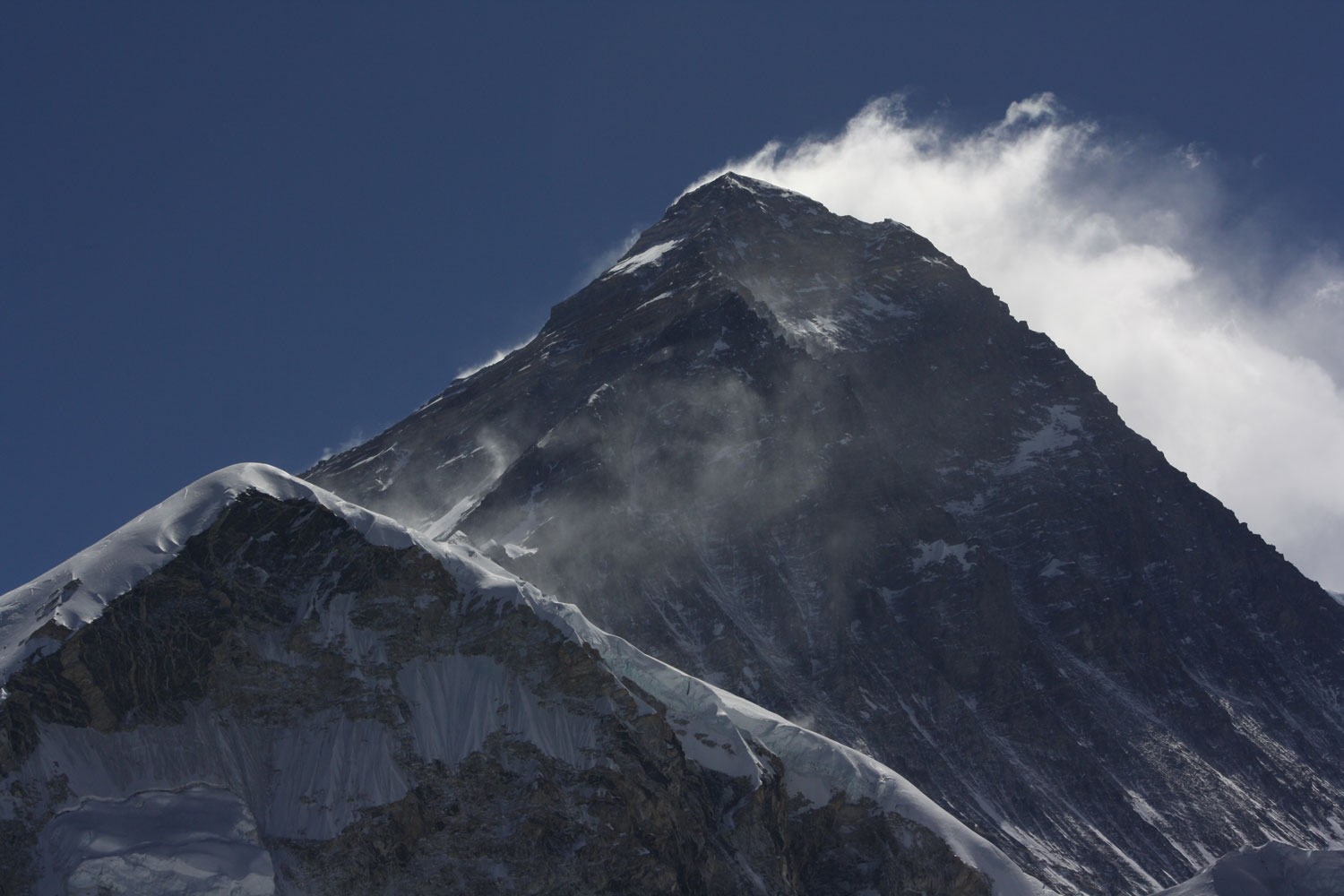
Mount Everest is arguably the most famous mountain in the world. 800 people attempt to summit each year but more than 500 trekkers get to base camp each day (you read that right!).
Everest is located in the Himalayas, on the border between Nepal and Tibet (China). The first successful ascent of Mount Everest was made on May 29, 1953, by Sir Edmund Hillary of New Zealand and Tenzing Norgay, a Sherpa of Nepal.
Climbing Mount Everest is a challenging and dangerous undertaking. It’s estimated that over 300 people have died attempting to summit since the first attempt in 1922. The exact number is difficult to determine since many bodies are impossible to recover. Factors including frostbite, exposure, falls, and avalanches contribute to the danger.
In recent years, the number of climbers on Mount Everest has skyrocketed. In 2019, the Nepal government issued a record of 800+ permits, allowing climbers to attempt the ascent. There are serious concerns about how this overcrowding of the mountain is impacting the environment and individual safety.
Mountaineers should carefully consider their Everest climb. Besides the months of preparation required, the average cost to climb Everest is tens of thousands of dollars for permits, guides, equipment, and other expenses.
2. K2, Pakistan and China (8,611m / 28,251 ft)
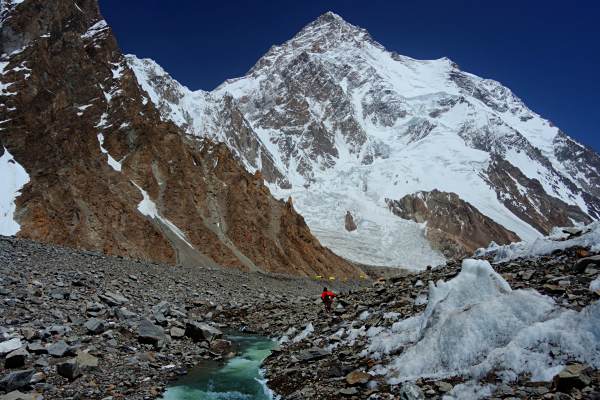
The second-highest mountain in the world stands on the border between Pakistan and China. K2 got its name during a the Great Trigonometrical survey of British India which kicked off at the start of the 19th century. It is the second-highest peak in the Karakoram range (K range), hence ‘K2’.
Occasionally, the mountain is referred to as Mount Godwin-Austen (after its first surveyor) or Chogori (‘Big Mountain’). A more common name is ‘Savage Mountain’ due to the notoriously difficult and dangerous ascent.
K2 has steep and rocky terrain, with a high risk of avalanches. The weather on this mountain is also unpredictable. Even though it's lower, climbing K2 is much more difficult than reaching the summit of Everest.
An Italian team made the first successful ascent of K2 in 1954. As of 2021, over 350 people have successfully climbed K2. More than 80 have died attempting to summit. Most people only trek to K2s base camp.
3. Kangchenjunga, Nepal and India (8,586m / 28,169 feet)
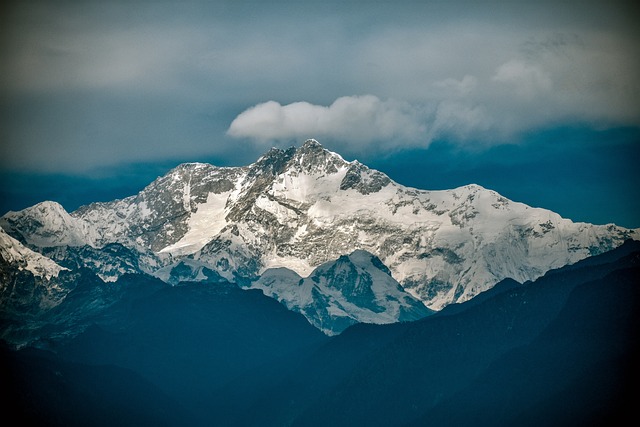
Sometimes spelled Kanchenjunga, this greta peak is located on the border between Nepal and India. The name "Kangchenjunga" means "Five Treasures of Snow" in Tibetan. This refers to the five peaks of the mountain.
Up until 1852, Kangchenjunga was believed to be the tallest mountain in the world. This was thanks to some incorrect early calculations. Later surveys in the 18th century, showed that Kangchenjunga is only the third-highest mountain in the world.
Brits Joe Brown and George Band were the first people to successfully summit Kangchenjunga during an expedition in May of 1955. The mountain is more remote than Everest or K2 and more seldom climbed.
This giant is a religiously important site to locals. In 2000 the Indian government declared it a ‘sacred landscape’. As such, the Indian side is off-limits to climbers.
4. Lhotse, Nepal (8,516m / 27,940ft)
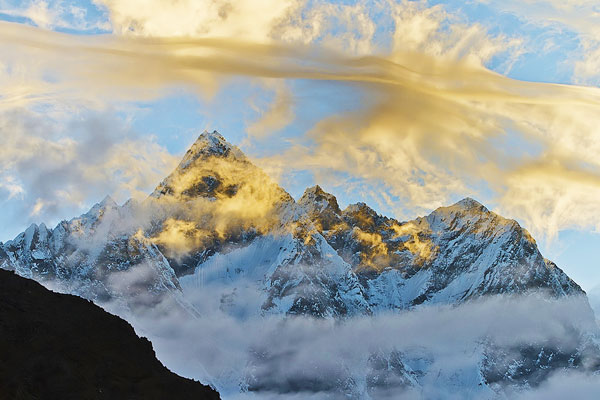
Located in the Everest region of Nepal, it is the fourth highest mountain in the world. The name "Lhotse" means "South Peak" in Tibetan. This refers to it being the southernmost peak of the Everest massif.
Lhotse is well-known amongst mountaineers because it is right beside Everest. The two mountains are connected by the South Col, a narrow ridge that sits at an altitude of 8,000 meters (26,000 feet). You start at Everest base camp and trek all the way to Camp 3 before the path deviates towards Lhotse summit.
Mount Lhotse is steep and technical. To make it to the summit, you will need to get up a section of rock climbing known as the "Yellow Band." The first successful ascent of Mount Lhotse was made by Fritz Luchsinger and Ernst Reiss on a Swiss expedition in 1956.
Mount Lhotse has three main summits: Lhotse Main, Lhotse Shar, and Lhotse Middle. Lhotse Main is the highest point on the mountain. Unlike its ultra-famopus neighbour, Lhotse is not nearly as busy a route. Lhotse Middle remained unclimbed until 2011.
5. Makalu,Nepal (8,485m / 27,838ft)
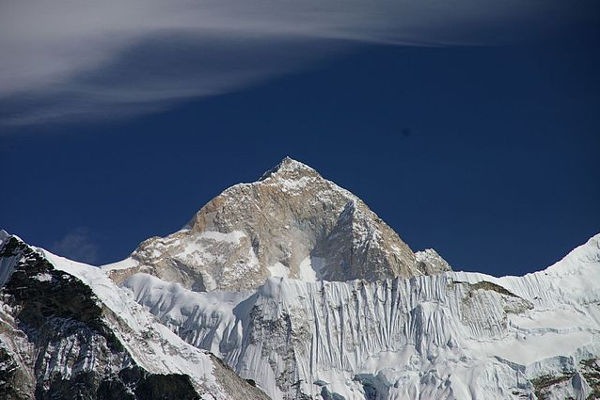
Makalu is a dramatic-looking, pyramid-shaped mountain in the Mahalangur Himalayas range, Nepal. It just makes the list of the 5 highest mountains in the world and is only 19km away from Everest.
he name "Makalu" comes from the Sanskrit word "Maha Kala," which means "Big Black." This efers to the dark granite rocks which cover most of the mountain's steep slopes.
The first attempt to summit was made by an America team in Spring of 1954. They had to tur back due to dangerous, stormy weather. In the same year, the legend, Sir Edmund Hilary made an attempt with a New Zealand expedition. They too failed due to injuries and illness.
A French team (Jean Franco, Lionel Terray, Jean Couzy, and Guido Magnone) where the first to reach Makulu’s summit on 15 May 1955. Their route via the northeast ridge became the standard way up the mountain. Japanese climbers Y. Ozaki and A. Tanaka were the first to make it up the south-east ridge in 1970.
Being so close to Everest, you would assume this is a very popular mountain to climb. However, Makula is fairly isolated in the Makulu Barun National Park. According to Nepal Tourism Statistics, there were only 37 successful summits in 2019.
6. Cho Oyu, Nepal and Tibet (8,188m / 26,864ft)
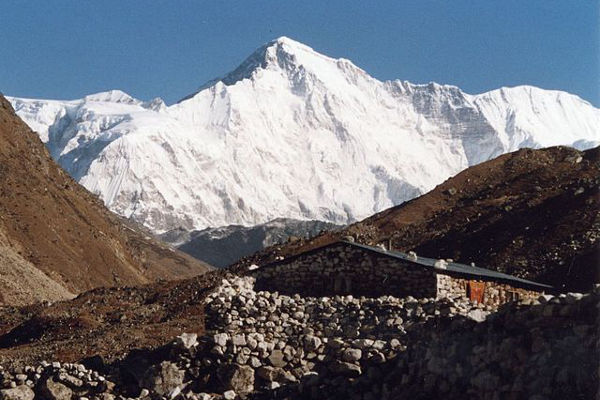
Cho Oyu, on the Nepal-Tibet border, is the sixth highest mountain in the world. Cho Oyu has striking blue glaciers. Its name means "Turquoise Goddess" in Tibetan. This refers to the striking blue color of the mountain's glaciers.
It has fairly gentle and non-technical route slopes and is often considered the easiest 8,000m peak to climb. It is the fourth member of the Everest range to make it onto this list. Cho Oyu is located just 20 kilometers (12 miles) west of Mount Everest. Climbers often use the same base camp and climb both peaks in succession.
Even though Cho Oyu is the most relaxed member of the 8000s club, it is still part of the Himalayas' "death zone". The lack of oxygen and extreme cold in this area above 8,000 meters can be lethal. Not to be taken lightly!
The first successful ascent of Cho Oyu was made by an Austrian expedition in 1954. Joseph Jöchler, Herbert Tichy, and Pasang Dawa Lama reached the summit on October 19th.
7. Dhaulagiri, Nepal (8,167m / 26,795ft )
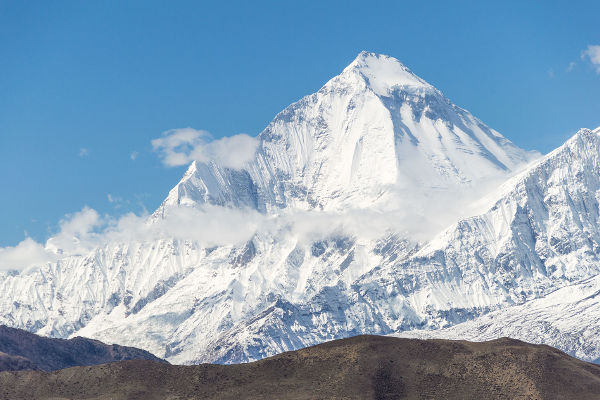
Located in Nepal, it is the seventh-highest mountain in the world. ‘Dhaulgiri’ means White Mountain". If you ask me, it's a bit of a lazy naming choice for a snow-covered mountain (Still, it’s better than K2).
Dhaulagiri is part of the Annapurna range of mountains, just 34 kilometers (21 miles) west of Annapurna Peak. The two are seperated by the Kali Gandaki Gorge, which is said (with some debate) to be one of the deepest gorges in the world. Climbers who often summit the two mountains from the same base camp. You can trek around this mountain on the Dhaulagiri circuit trek.
Dhaulagiri has a reputation for being one of the most challenging 8,000m peaks to climb. There is an especially treacherous section of icy cliffs known as the "Dhampus Pass."Up until 2007, there had been 358 recorded successful climbs and 58 deaths on the mountain. That’s a pretty horrendous 16% summit to fatality rate.
The first successful expedition was a Swiss-Austrian team alongside local Sherpas. They reached the summit on 13 May 1960. Up until 2022, only around 650 people had successfully reached the top
8.Manaslu, Nepal (8,163m / 26,781 ft)
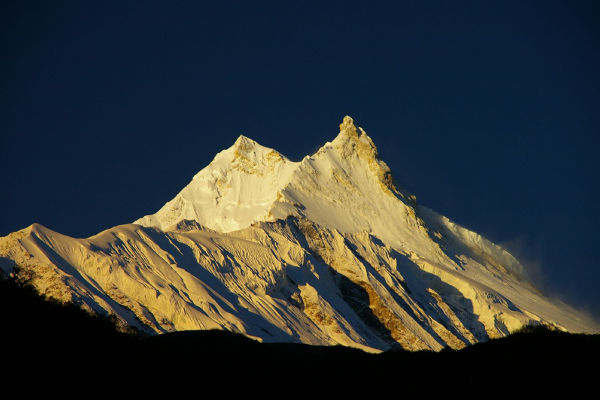
Coming in at number eight is Mount Manaslu in the Mansiri Himalayas range of Nepal. This mountain, sometimes called Kutang, is in a very remote part of Nepal and is the highest peak in the Gorkha district. The climb takes mountaineers through some of the country’s most stunning and rugged landscapes.
Manaslu has a huge significance within the local culture. The region around the mountain is home to a number of ethnic groups, including the Gurung, who have their own language, culture, and traditions. The name, pronounced, muh-NUH-slu, means ‘Mountain of the Spirit’.
Locals were not very happy about the first attempted ascents. They blamed early Japanese expeditions for displeasing the gods and causing avalanches that destroyed a monastery and killed 18 people. Eventually in 1956 (after some persuasion in the form of donations) another Japanese team became the first to reach Manaslu peak.
Luckily, today foreign tourism is more welcome in the region. There are 6 well-established trekking routes to reach this summit as well as the popular Manaslu circuit trek. To summit Manaslu, you need to have experience in rock climbing and technical climbs across ice.
9.Nanga Parbat, Pakistan (8,126m / 26,650 ft)
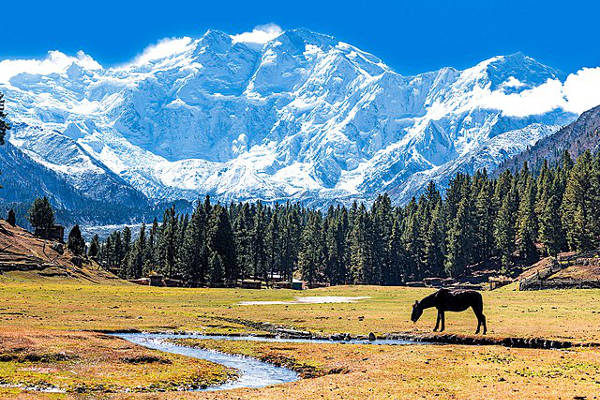
Nanga Parbat comes in at number 9 of the tallest mountains in the world. Nanga Parbat comes from Sanskrit meaning ‘Naked Mountain.’ In Tibetan, it is known as Diamer (huge mountain). Nanga Parbat is located in the northernmost region of Pakistan's Gilgit-Baltistan province.
It is often called "Killer Mountain" due to a high number of climber fatalities. Over 30 climbers have lost their lives on the mountain since 2000. The risks of climbing Nanga Parbat include avalanches, falls, and extreme altitude sickness
The first successful ascent was made in 1953 by German-Austrian climber Hermann Buhl. Prior to this, 31 people had already died attempting to climb Nanga Parbat. A rich mountaineering history includes one of very few successful high-altitude rescues. In 2005, a Pakistani military helicopter saved a Slovenian climber who had been stranded under an ice ledge for 6 days.
Everest and Nanga Parbat are the only two mountains in the world that rank amongst the tallest mountains in the world as well as the top 20 most prominent peaks.
10. Annapurna, Nepal (8,091m / 26,545 ft)
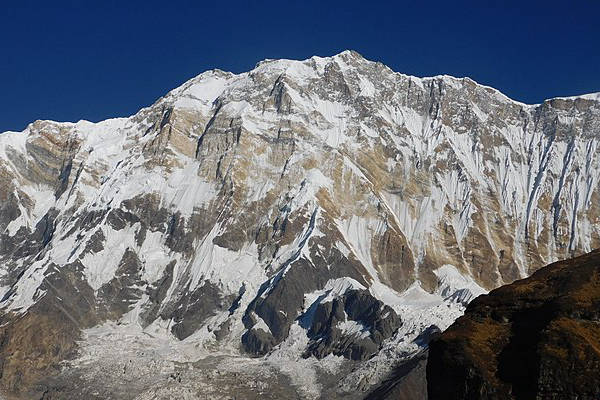
Last but not least is Annapurna. Despite being last on the list of the 10 highest mountains in the world, Annapurna is considered the second most difficult and dangerous mountain to climb (after K2). Its slopes are steep and avalanche-prone.
Surprisingly, Annapurna was the first of the eight-thousanders to be climbed. French mountaineer Maurice Herzog and his team made the first successful ascent of Annapurna in 1950.
For a long time, Annapurna held the highest fatality-to-summit rate of all the world’s highest mountains, a whopping 32%. Luckily, this has decreased. Between 2012-2022 the fatality rate was somewhat lower at 20%. This is still more than enough to make you think twice before attempting to summit!
Annapurna's south face is a particularly hazardous climb. This 3,000m (9,800ft) face is famous as one of the most difficult ascents in the world.
The Annapurna region is a famous trekking area. Here you find the Annapurna circuit and Annapurna sanctuary hike. Easily some of the best thru-treks in the world.
What About The Other 8000ers?
In total, there are 14 mountains in the world with summits above 8000m. Even though the last few didn’t make the cut as top 10 tallest mountains in the world, they are giants in their own right and deserve some credit.
The other four 8000s are:
- Gasherbrum 1 (8,080m / 26,510ft ) - Located on the border of Pakistan and China. This mountain also goes by ‘K5’ or ‘Hidden Peak’.
- Broad Peak (8,051m / 26,414ft), - Also on the Karakoram range bordering Pakistan and China, this mountain has 5 summits and was first ascended in 1957 by an Austrian expedition.
- Gasherbrum 11 (8,034m / 26,358) - The third highest peak in the Gasherbrum massif and 13th tallest mountain in the world. This mountain was surveyed as ‘K4’.
- Shishampangma (8,027m /26,335ft ) - Located in China, Shishampangma is also known as Gosainthan. The name means a grassy plain/ meadow above a crest in the Tibetan language.
Tallest Mountains In The World On Each Continent
As you may have noticed, all of the worlds highest mountains arein the Asian mountain ranges This is a little boring if you want to do mountain climbing by destination. To remedy this, mountaineers created the Seven Summits Challenge.
The first person to climb all seven summits was Richard Bass in 1985. At this time, travel was a tricky and expensive business. Today, it’s a whole lot easier to get around the globe.
The seven summits are the highest mountains on each continent. Everest of course, represents Asia, Kilimanjaro (Africa), Denali (North America), Aconcagua (South America), Mt Elbrus (Europe) and Mt, Vinson in Antartica. Puncak Jaya (The Carstensz Pyramid) is the more commonly accepted candidate for Australasia. This replaces Mt. Kosciuszko which was on Bass’s original list.
An alternative to the seven summit challenge is to climb the 7 volcanic summits. These are the highest volcanos on each continent. There is some overlap between the seven summits and seven volcanic summit lists.
Also Read: The Most Beautiful Mountains In The World

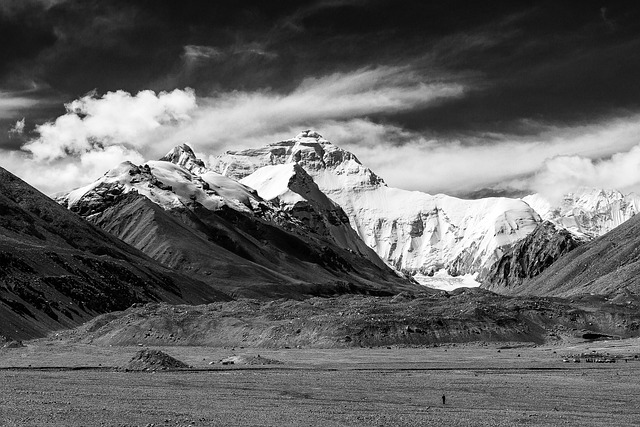
Loved the article . Very informative.
Wonderful knowledge
Everest represents Asia. Please correct in last but one para.
Thanks for catching that, fixed
You confuse highest with tallest. Everest is the highest but Mauna Kea is the tallest.
Hi Ken
It does get a bit confusing depending on terminology. Most people think of the world’s tallest mountain as the one with the highest elevation above sea level, which is what I went with in this article. Indeed, if you look at the actual height of the mountain (measurement base to peak), Mauna Kea (33, 500ft/ 10,210m) is technically ‘taller’ than Everest.